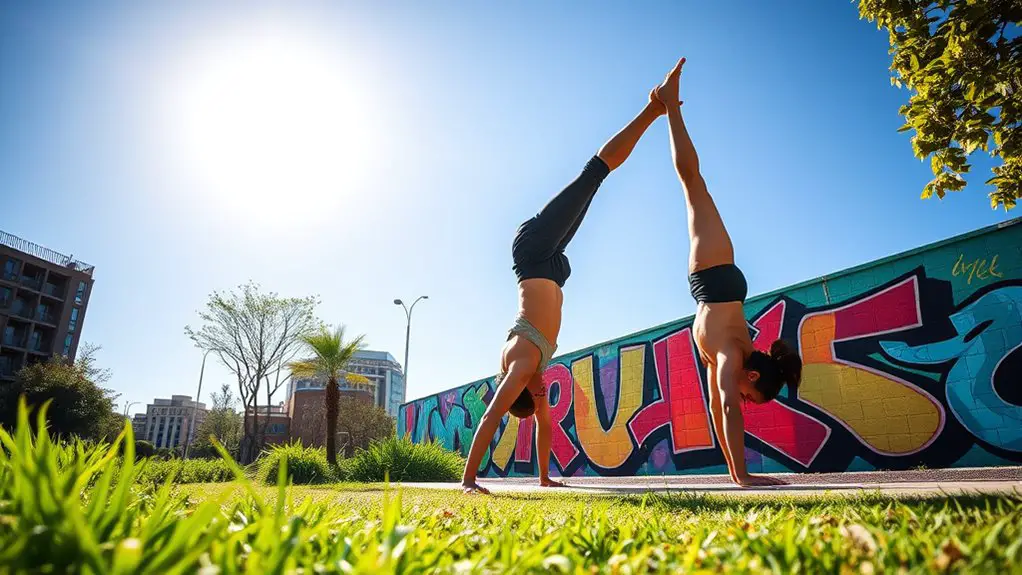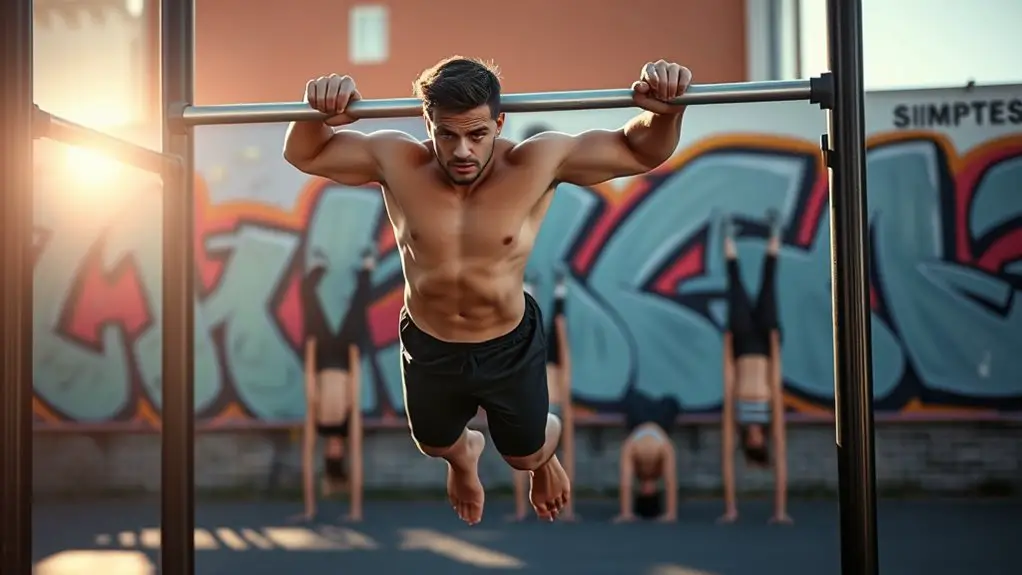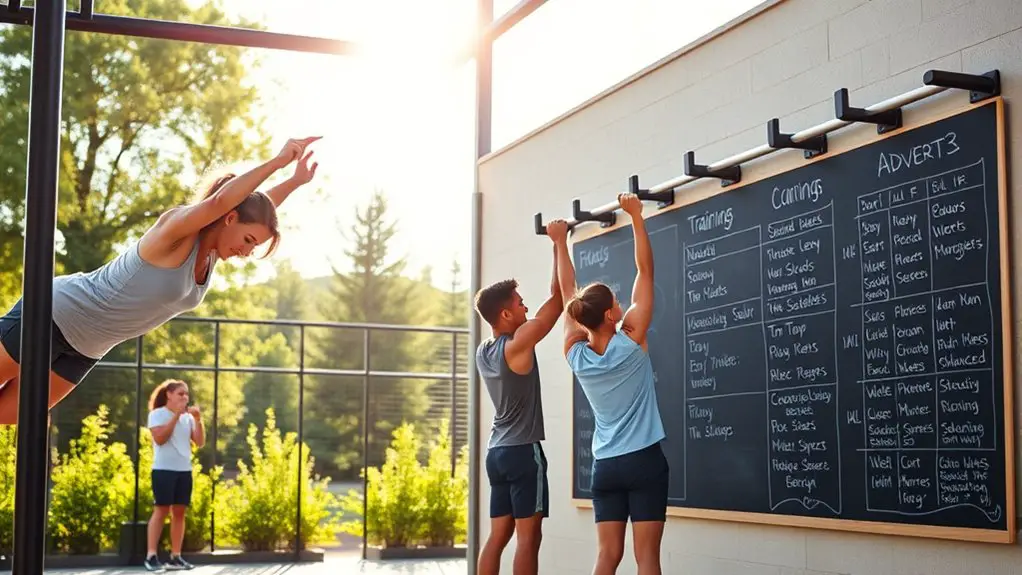How to Transition From Beginner to Advanced Calisthenics

To shift from beginner to advanced calisthenics, focus on mastering fundamental exercises like push-ups and pull-ups. Set specific, achievable goals that build confidence, such as performing five consecutive pull-ups. Incorporate intermediate exercises and start practicing advanced variations to enhance strength and control. Stick to a consistent training routine with three to four sessions a week, tracking your progress along the way. Keep pushing your limits, and you’ll soon uncover more strategies to elevate your practice even further.
Understanding the Fundamentals of Calisthenics

Calisthenics is more than just a workout—it’s a powerful way to harness your body’s strength and control. To truly excel, you’ll need to grasp the fundamentals of bodyweight mechanics and movement patterns. Understanding how your body moves is essential for mastering exercises like push-ups, pull-ups, and squats.
Start by focusing on your form; proper alignment helps prevent injuries and builds a solid foundation. Pay attention to your core engagement, as it’s vital for stability in every movement. As you progress, explore different movement patterns, like dynamic and static holds, to enhance your strength and flexibility.
Setting Realistic Goals for Progression
How can you effectively set goals that will propel your calisthenics journey? Start by identifying specific, measurable objectives. Instead of vague aspirations like “get stronger,” aim for tangible goals like “perform five consecutive pull-ups.” This approach makes your goal setting more focused and achievable.
Next, break your goals into smaller milestones. For instance, if you’re working towards a muscle-up, aim to master the pull-up and dip first. This not only builds your confidence but also helps with progress tracking.
Mastering Key Intermediate Exercises

As you progress in your calisthenics journey, mastering key intermediate exercises becomes essential for building strength and confidence. Focus on movements like the pull-up, dip, and push-up variations, which lay the groundwork for more advanced skills. These intermediate exercises not only enhance your strength development but also improve your overall body control.
Start by perfecting your form; quality over quantity is vital here. Incorporate negatives and assisted variations if you’re struggling, as they can help you build the necessary strength. As you gain proficiency, challenge yourself with added resistance or advanced variations.
Incorporating Variations and Advanced Techniques
While you’ve laid a solid foundation with intermediate exercises, incorporating variations and advanced techniques is essential for taking your skills to the next level. These advanced progressions not only enhance your strength but also improve your overall control and body awareness. Start by adding variations to your favorite moves, like archer push-ups or one-arm pull-ups, to challenge your muscles in new ways.
As you explore these advanced techniques, focus on skill mastery. Break down complex movements into manageable parts, practicing each component until you feel confident. This approach not only builds strength but also boosts your confidence as you progress. Additionally, incorporating alternative exercises can provide a different stimulus to the muscles worked and help prevent plateaus.
Don’t shy away from using equipment, like resistance bands or gymnastic rings, to facilitate your shift. Remember, consistency is key; practice regularly, and don’t rush the process. Embrace the journey, and you’ll find your abilities expanding beyond what you thought possible.
Developing a Consistent Training Routine

To guarantee steady progress in your calisthenics journey, developing a consistent training routine is essential. Start by evaluating your schedule and prioritizing time management. Determine how many days a week you can realistically commit to training. Aim for at least three to four sessions weekly to build strength and endurance effectively.
Next, set specific goals for each workout, focusing on different muscle groups or skills. This way, you’ll maintain workout frequency while preventing burnout and overtraining.
Keep track of your workouts to stay accountable and measure your progress. If consistency is a challenge, consider scheduling your workouts like important appointments—this creates a sense of commitment.
Finally, remember that progress takes time, so celebrate small victories along the way. With dedication and a well-structured routine, you’ll shift smoothly to advanced calisthenics and reveal your full potential!
Frequently Asked Questions
How Long Does It Typically Take to Progress to Advanced Calisthenics?
Ever wondered how long it takes to reach advanced calisthenics? The progression timeline can vary greatly from person to person. Generally, you might find yourself hitting skill milestones like the muscle-up or handstand within months to a couple of years, depending on your dedication and consistency. Stay patient, focus on mastering the basics, and celebrate each small victory along the way. With perseverance, you’ll see progress sooner than you think!
Can I Do Calisthenics if I Have Previous Injuries?
Yes, you can definitely do calisthenics even with previous injuries! It’s essential, though, to listen to your body and incorporate injury modifications. Start with rehabilitation exercises that strengthen the affected area and gradually progress from there. Focus on building a solid foundation, and don’t rush your recovery. Remember, patience is key. You’ve got this, and with consistent effort, you can achieve your fitness goals while keeping your body safe and healthy!
What Nutrition Tips Support Calisthenics Training?
To support your calisthenics training, focus on macronutrient balance. Make certain you’re getting enough protein for muscle repair, healthy fats for energy, and carbohydrates for fuel. Meal timing is essential too—try to eat a balanced meal or snack about 1-2 hours before your workout and refuel with protein and carbs afterward. Staying hydrated is key as well. With the right nutrition, you’ll feel stronger and more energized during your sessions!
Should I Incorporate Weights Into My Calisthenics Routine?
Incorporating weights into your calisthenics routine can be a game-changer. Weight benefits include increased muscle strength and improved endurance, which can enhance your overall performance. By adding resistance training, you challenge your muscles differently, promoting growth and adaptation. You don’t have to go heavy right away; start with moderate weights and focus on form. It’ll keep your workouts fresh and exciting, pushing you closer to your fitness goals. Keep going—you’ve got this!
How Can I Prevent Plateaus in My Training?
Imagine your training journey as a river, flowing smoothly until it hits a dam. To prevent those plateaus, you need to carve new channels. Start by tracking your progress diligently, like a traveler marking each milestone on a map. Embrace skill mastery by challenging yourself with new moves or variations. Consistency is your paddle; use it wisely. Keep your workouts fresh and exciting, and soon you’ll find that river flowing freely again.





